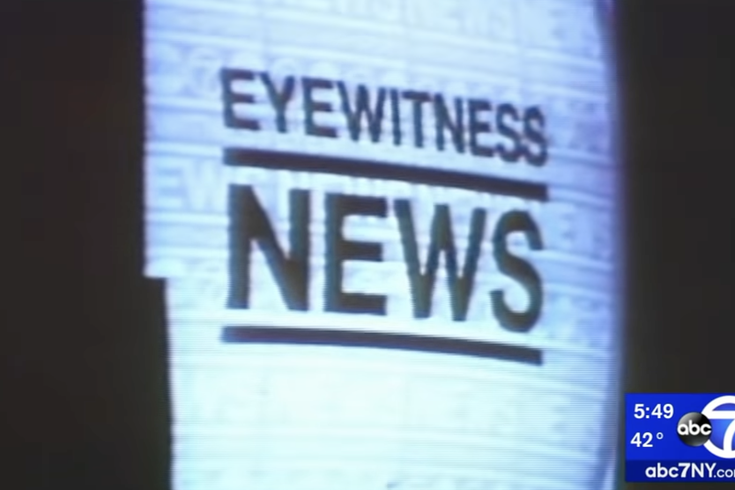
February 07, 2023
 Eyewitness News ABC7NY/YouTube
Eyewitness News ABC7NY/YouTube
Red Crown Productions has optioned the television rights for Layla A. Jones' 2022 Philadelphia Inquirer story 'Lights. Camera. Crime,' which examined the history and impact of the Eyewitness News local television format, which originated in Philadelphia in 1965.
A newly-optioned television series will examine the history of the Eyewitness News local television format and the ways in which it popularized harsh criminal justice policies by portraying Black residents as criminals.
The scripted series will be adapted from "Lights. Camera. Crime," an investigative story written in March 2022 for the Philadelphia Inquirer's "A More Perfect Union" project. Layla A. Jones, the Inquirer's economic equity reporter, explored the history of the "if it bleeds, it leads" local news format that was born in Philadelphia and expanded into more than 141 media markets in the late 20th century. It remains the primary format for local news stations across the country.
The series, which will include fictionalized scripted accounts of the incidents in Jones' story, will be adapted by Red Crown Productions, a film studio best known for projects like "Hello, My Name Is Doris," "Beasts of No Nation" and "What Maisie Knew," Variety first reported on Tuesday. Daniel Colameco is set to write the script, with Yance Ford on board to direct.
"Immediately after reading Layla's article I knew how significant this story was," Daniel Crown, co-founder of Red Crown, told Variety. "This is an eye-opening look into the history of Eyewitness News and its impact. My hope for this series is that it opens the conversation up to the dangers of sensationalized news. Yance could not be a more perfect voice and visionary to join this project and I am so honored to be working with him and Daniel."
Jones said that she expects to be working with the series' producers, Yance and Colameco, as well as consulting with the production team as the project gets underway.
"I'm incredibly excited and feel blessed to have one of my pieces take on a life of its own," Jones said. "The story was about how local television news used negative stereotypes and sensationalized crime coverage of Black people and our neighborhoods to raise ratings and ad revenue. Along the way (they) reinforced prejudices, made people feel less safe and influenced members of the public to support harsher criminal justice policies. The producers and director are invested in making sure this story is told to help continue the conversation about the impact of local TV news."
The news is out! My @PhillyInquirer piece "Lights. Camera. Crime." has been optioned by @RedCrownProd with director @yford and writer Daniel Colameco. They're adapting it to become a scripted TV series.
— Layla Jones (@bae_lay) February 7, 2023
Very, very cool, unreal, exciting blessing. https://t.co/TW1kD6GMtC
Jones' original story focused on Tyrone Williams, a 55-year-old Black man from Olney, who had been stabbed 20 years prior in a racist attack. The story behind Williams' beating was broadcast on Eyewitness News and Action News after it occurred, with two pioneering Black journalists showing up to report the crime story. They, along with many other journalists in Philadelphia, did not follow up on the case as it progressed.
Williams told the Inquirer that he never really saw the news in his neighborhood unless "something blew up," referencing the oft-used format of local news programs that center crime and danger. This format, first spearheaded by Eyewitness News founder Al Primo in 1965, would "transform how Americans received the day's headlines."
When the Eyewitness News format debuted, Primo repackaged the day's biggest news into "infotainment," which Jones describes as a fast-paced series of vignettes delivered by a "news family," which included a male and female duo of anchors in the studio and several field reporters on the scene.
This format helped draw in viewerships and provided a massive boost for ratings, which helped it expand into other media markets. By 1970, more than 35 stations had adopted the format, including Action News, which launched that year with a more upbeat format and heavier focus on crime, Jones reported.
The fast-paced style that is often still seen on local news programs like Action News and Eyewitness News has received an abundance of scrutiny in recent years, as critics believe that news programs should do more to reflect the regions they cover and provide a fuller picture of the communities they enter.
When the Inquirer story was published early last year, it was accompanied by a video that included recorded interviews with Primo and pioneering Philadelphia journalists who were tasked with reporting in the Eyewitness News format when it first debuted. The video is available below.